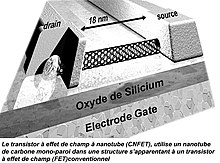Carbon nanotube field effect transistor
Carbon nanotube field-effect transistor ( English carbon nanotube field-effect transistor , CNTFET) is a further development of the field effect transistor (FET) in which parts of the semiconductor structure by carbon nanotubes have been replaced (CNT).
The first functional CNTFETs were presented in 1998 by a group from Delft University .
The CNTFETs are smaller than the present (2010) in the microelectronics usual metal-insulator-semiconductor field-effect transistors based on silicon are and as one of the components that could replace in the coming years or decades it. In addition to the size, the higher electrical conductivity of the CNTs and the associated higher achievable switching and transit frequencies is a major advantage of this technology. The targeted manufacture of the individual transistors is currently still causing major problems.
literature
- Lorraine Rispal: Large Scale Fabrication of Field-Effect Devices based on In Situ Grown Carbon Nanotubes . Dissertation, Technical University of Darmstadt. 2010 ( ulb.tu-darmstadt.de [PDF; accessed on July 12, 2017]).
Web links
- Article of the TU Darmstadt
Individual evidence
- ↑ Sander J. Tans, Alwin RM Verschueren, Cees Dekker: Room-temperature transistor based on a single carbon nanotube . In: Nature . tape 393 , no. 6680 , April 7, 1998, pp. 49-52 , doi : 10.1038 / 29954 .
